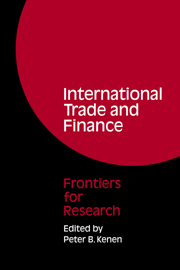Book contents
- Frontmatter
- Contents
- List of Contributors
- Preface
- PART I TRADE, PROTECTION, AND DOMESTIC PRODUCTION
- PART II ECONOMETRIC MODELS OF TRADE AND PAYMENTS
- Price, Incomes, and Foreign Trade
- The Multinational Corporation and Direct Investment
- Empirical Research on Financial Capital Flows
- Discussion
- Part III PAYMENTS ADJUSTMENT AND THE MONETARY SYSTEM
- PART IV AN OVERVIEW AND AGENDA
- Glossary of Frequently Used Acronyms
- Author Index
Price, Incomes, and Foreign Trade
Published online by Cambridge University Press: 05 November 2011
- Frontmatter
- Contents
- List of Contributors
- Preface
- PART I TRADE, PROTECTION, AND DOMESTIC PRODUCTION
- PART II ECONOMETRIC MODELS OF TRADE AND PAYMENTS
- Price, Incomes, and Foreign Trade
- The Multinational Corporation and Direct Investment
- Empirical Research on Financial Capital Flows
- Discussion
- Part III PAYMENTS ADJUSTMENT AND THE MONETARY SYSTEM
- PART IV AN OVERVIEW AND AGENDA
- Glossary of Frequently Used Acronyms
- Author Index
Summary
This paper examines econometric models that relate prices and incomes to aggregate international trade flows. A number of trade surveys should be mentioned. Harley (1966) surveyed empirical work done in the 1960s on U.S. trade, and Taplin (1967) has surveyed world trade models. Prais (1962) did an earlier paper on econometric work in international trade, and Cheng (1959) did an exhaustive survey of empirical estimates of international trade elasticities and propensities. Hultman (1967) has examined the relationship between exports and growth. Both Bloomfield (1969) and Krueger (1969) have surveyed international economics generally, and the Krueger study has a good, though somewhat dated, discussion of the effects of devaluations on the trade balance.
The most extensive survey of econometric work in international trade is contained in Leamer and Stern (1970). I will try to avoid duplicating their rather thorough treatment of specification and estimation problems, the relationship between demand and substitution elasticities, and other topics.
There are both positive and normative reasons for interest in econometric trade models. From a purely scholarly point of view, we are interested in the relationship between the international and domestic sectors of national econometric models (see Buckler and Almon, 1972; Helliwell et al., 1969; Hooper, 1972; Klein's report on project LINK in this volume; and Rhomberg and Boissonneault, (1965). There is also a positive interest in the international transmission of economic activity (in addition to Klein, see Brems, 1956, and T.R. Robinson, 1968).
- Type
- Chapter
- Information
- International Trade and FinanceFrontiers for Research, pp. 175 - 252Publisher: Cambridge University PressPrint publication year: 1976
- 11
- Cited by



